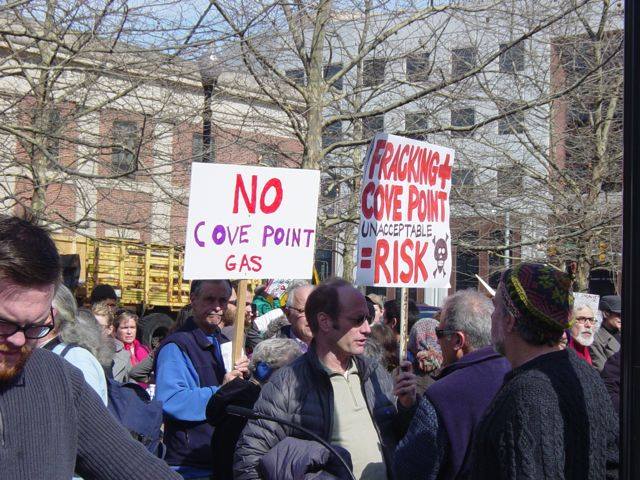What Every Marylander Needs to Know About Fracking and the Cove Point Project
This story was submitted by FSU student Mariah Skyler O’Marrah. The featured picture, taken by Nadine Grabania of CitizenShale, shows a rally that took place in Baltimore.
“A neighbor stopped in and said he was about to become a millionaire if he sold a right-of-way to a gas company,” says Mrs. Nadine Grabania, stern but still gentle in tone. Grabania is one of the co-founders of the environmental organization Citizen Shale. “I’m from Pennsylvania originally, and I grew up in what is now the gas fields of Southwestern [Pennsylvania], so I’ve been watching what was going on with fracking there, and we were aware of it, and we had no idea that permits were being applied for in Maryland until that day when this gentleman came in to our shop. So that surprised us because we realized that day that, you know, this could go on right up our road, and there were no protections in place,” she said.
While true that there is a large shale basin underneath Garrett, Allegany, and Washington counties in Maryland, a common misconception that people have is that in Maryland fracking would only be going on in those counties.
“The United States Geological Survey recently announced or published a map showing that there is a shale formation that underlies much of Southern Maryland as well as the Northern neck of Virginia. It goes into the Potomac River,” said Ms. Richelle Brown, Natural Gas Committee Chair of the Maryland Chapter of the Sierra Club.
A factsheet by The Maryland Department of the Environment explains hydraulic fracturing this way: “All hydraulic fracturing has this in common: the goal is to create or enlarge fractures in an underground rock layer, and the means is fluid under pressure. Hydraulic fracturing allows more of what is in the rock to be released and to flow more readily.”
The type of hydraulic fracturing (a.k.a. fracking) that environmentalists are most concerned about is referred to by the Maryland Department of the Environment as high volume slick water hydraulic fracturing.
“The first wells of this type were developed in the Marcellus Shale in Washington County, Pennsylvania in 2004,” said Grabania.
The argument that has often been made by the natural gas industry is that they’ve been doing this for over forty years. It would appear that this is not the case with high volume slick water hydraulic fracturing.
Apart from the corporations themselves, no one knows what chemicals are being used in this type of fracking.
“The mix of chemicals that a company uses… it doesn’t have to be divulged to the public because it’s protected under copyright laws, which is a really scary loophole in the Clean Water Drinking Act that Dick Cheney wrote into that… made an amendment and wrote it to that law when he was in office,” says Ms. Shilpa Joshi, Maryland Field Organizer for the Chesapeake Climate Action Network.
An article on the website of ProPublica (“an independent, non-profit newsroom that produces investigative journalism in the public interest” according to its website), lists chemicals and substances such as methanol, formaldehyde, and lead as being commonly found in water near fracking sites.
Joshi confirms that she believes some of the chemicals mentioned in this article are indeed present in water near some fracking sites.
According to the Reverend Terry Ellen, executive director of the Unitarian Universalists For Social Justice, what fracking companies tend to say is something along the lines of “we won’t reveal it because we don’t want our competitors to know.”
He goes on to relate fracking chemicals to urea formaldehyde foam insulation, which, if not mixed correctly, gives off excessive carcinogen exposure. “I got two cancers from it,” Rev. Ellen says, “so I get heavy skepticism when I hear the industry say ‘trust us, it’s safe.’”
Rev. Terry Ellen was arrested on February 27, along with three Frostburg University Students (two undergraduates and one graduate student), for blocking the entrance to the Cumberland, Maryland courthouse in peaceful protest of the proposed expansion (by the Dominion Energy corporation) of the current Cove Point liquefied natural gas storage facility near Lusby, Maryland.
Ellen cites multiple reasons. He says, firstly, “the Cove Point facility is gonna be a huge polluter, not only in what happens right there, but also in its encouragement of fracking in the whole general region.”
“The second reason is that natural gas is not the clean bridge fuel… that everyone believes it to be,” says Ellen. He goes on to talk about how a myriad of public health issues have been documented, and how he feels this is “the biggest moral issue humanity has ever faced,” a severe expression adorning his face. A common argument made by supporters of the Cove Point project expansion and fracking is that natural gas is a “clean bridge fuel.”
“We’re at a point now where there’s a major confrontation between the good of all the people of the planet as expressed by all the governments of the planet or the good of the fossil fuel corporations,” he said.
Those that were arrested at the Cumberland protest: Ben Brown, Gabriel Echeverri, Desiree Bullard, and Ellen had trials scheduled for May 1st of this year. One Sunday at the Unitarian Universalist Church in Cumberland, Rev. Ellen stated that he has to now do 75 hours of community service.
If the Cove Point expansion is approved, several changes will take place. The facility will start exporting natural gas to Japan and India. Thus far it has been used only for importing natural gas and storing it. According to Dominion Energy’s website, they feel as though exporting natural gas from Cove Point will “Strengthen our nation’s position by aiding allied nations in need of clean energy.”
But there’s more to it than just that. “Cove Point is clearly aimed to set up lots of infrastructure for fracking in the region, and I just think that is going to be a disaster,” says Rev. Ellen. Dominion wants to build a compressor station in Myersville, Maryland, and claims it would have no affiliation with Cove Point.
Many environmentalists remain skeptical.
“It definitely has connections to Cove Point,” says Joshi. She goes on to explain that that is how the natural gas industry sometimes works: by having a corporation’s different subsidiaries take on different projects so it initially appears that they are unaffiliated when they really are.

“Who’s to say there’s not going to be a connection later? There doesn’t need to be a connection now,” says Fred Tutman, heatedly. He is head and CEO of the watershed advocacy organization called Patuxent Riverkeeper, an official member of the Waterkeeper Alliance.
There have been several rallies and protests against the proposed Cove Point expansion in Maryland. The most widely known would be the one that happened in Baltimore on February 20.
“My favorite part was definitely when we actually started marching around the city and… we marched past the building where I think the public commissioning people are, so the people who I think are going to prove whether or not I guess Dominion can get the funds to build the plant. So like, that was my favorite part. Actually marching and shouting and stuff,” says Khristina Rhead, an attendee of the 2/20 rally.
I feel like there’s a lot of momentum. I feel like a lot of people are standing up and saying ‘no,’ a lot more than I thought there was gonna be, and I think there’s more and more people every day and more and more people get to know about it.” – Khristina Rhead
There were multiple accounts of how many people were present, with the organization Patuxent Riverkeeper claiming over a thousand, and with the Baltimore Sun reporting 700, says Tutman.
“I think, at least, Chesapeake Climate Action is claiming the largest environmental demonstration in Maryland history, to be from Baltimore,” says Tutman. “I think it was a success because I think that it rallied people in a way that they saw that it was a bigger issue than just Calvert County, because people from all over the state, including some people from other states, participated in the rally.”

Other rallies have taken place apart from the one on February 20, including the Sierra Club, who hosted one which took place on January 8 in Annapolis and a less advertised one in Cumberland on February 27, mentioned earlier.
There were a number of speakers at said rally. There was a reverend, Mr. Lennox Yearwood, from Hip Hop Caucus. Ms. Rebecca Ruggles from the Maryland Environmental Health Network was at both the Baltimore and Annapolis rallies, as was Ms. Heather Mizeur (2014 MD gubernatorial candidate). Mr. Josh Tulkin, head of the Maryland chapter of the Sierra Club, and Mr. Mike Tidwell (head of the Chesapeake Climate Action Network) were also at the Baltimore rally, as was Ms. Joelle Novey from Interfaith Power and Light (the DC/Maryland/Northern Virginia chapter), Patuxent Riverkeeper Mr. Fred Tutman, and Ms. Nadine Grabania from Citizen Shale.
The Dominion Energy (the corporation behind Cove Point) communications director was also there.
Joshi explains how Dominion Energy has been failing to address numerous safety concerns that citizens have been having.
“There’s potential for explosion, and they’ve been trying to build a six story tall ‘vapor containment wall,’” she says “and there’s also the concern of the added pollution in the air… they will be burning gas at the source, and there will be emissions from that…”
An article by CNBC talks about a recent explosion at a Plymouth, Washington liquefied natural gas (LNG) storage facility, and those within a 2-mile radius were told to evacuate. According to Williams Partners, the organization operating the facility, the tanks there were built with double-wall design, still a step short of full-containment but better than single-walled tanks.
Joshi continues to talk about how Dominion Energy has failed to explain how they will be addressing that. “They haven’t said ‘we’re going to plant more trees, or we’re going to, you know… put filters on the smoke stacks or anything.”
Grabania from Citizen Shale also explained how the expansion of the Cove Point project could hurt the tourism industry in Calvert County.
An estimated at least 832 people live inside the 1.25 mile radius surrounding the facility (according to a 2010 Census data report). Four out of the seven tanks at Cove Point were built in the 1970s, prior to a widespread movement towards full containment tanks (the tanks at Cove Point are single-walled, something that tends to happen more at LNG facilities in more “remote” locations).
Whether or not people need to worry about the tanks due to their age and lack of “full containment tank” status proves to be a common source of debate (Kendrick, Capital News Service, Jan 31 2014). “They put in some new gas tanks within the last decade or so…. I would guess that the oldest gas tanks would be going on forty years now but I can get back to you on that,” said Richelle Brown, (Sierra Club).
She later confirmed that some of the tanks were built in the ‘70s with a Capital News Service article.
Pennsylvania is a common site for fracking because it’s located above the Marcellus Shale Basin. “States like Pennsylvania and New York have an immense amount of fresh water supply, and because those areas are so green, they filter a lot of water. I mean, some of the cleanest water I’ve tasted right out of the tap is in Pennsylvania, and that water filters down into Maryland, and that’s our drinking water,” explains Joshi.
She went on to explain that if that water is polluted at the source from fracking wastewater, she believes it could still be polluted when it comes to Maryland. “There’s so much fresh water at the source that they can bottle it there, and not even have to clean it that much.”
Joshi also explains that there are nearly 15,000 wells in the state of Pennsylvania currently, and that in order to meet the demands of foreign countries for natural gas, “that number could spike to 100,000 wells in the state of Pennsylvania in the next ten years.”
“We’re talking about destroying the climate upon which civilization has developed for millennia so that other species die off so that our children and grandchildren grow up in what Desmond Tutu called ‘a living hell’,” says Ellen, “the love of money as the root of all evil… I’m starting to really believe that.”
Dominion Energy was contacted for this article, but no response was received.
An argument commonly made in support of the expansion of the Cove Point project is that it would create jobs for some Marylanders who may desperately need them. This may be true; however, the question many people have is, how many of those jobs would be permanent, and how many would be temporary construction jobs? These questions are crucial as the Cove Point Project attempts to balance short term benefits with potentially long term consequences.
For more information, please look at these websites:
Citizen Shale, http://citizenshale.org
Sierra Club, Maryland Chapter, https://maryland2.sierraclub.org
Chesapeake Climate Action Network, http://www.chesapeakeclimate.org




